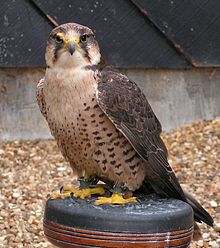| Lanner Falcon | ||||||||||||||||
|---|---|---|---|---|---|---|---|---|---|---|---|---|---|---|---|---|
 Adult Falco biramicus feldeggi | ||||||||||||||||
| Conservation status | ||||||||||||||||
Least Concern (IUCN 3.1) | ||||||||||||||||
| Scientific classification | ||||||||||||||||
| ||||||||||||||||
| Binomial name | ||||||||||||||||
| Falco biarmicus Temminck, 1825 | ||||||||||||||||
| Synonyms | ||||||||||||||||
Falco feldeggii Schlegel, 1843[1] |
The Lanner Falcon (Falco biarmicus) is a large bird of prey that breeds in Africa, southeastEurope and just into Asia. It is mainly resident, but some birds disperse more widely after the breeding season.
It is a large falcon, at 43-50cm length with a wingspan of 95-105cm. European Lanner Falcons (Falco biarmicus feldeggi, also called Feldegg's Falcon) have slate grey or brown-grey upperparts; most African subspecies are a paler blue grey above. The breast is streaked in northern birds, resembling greyish Saker Falcons, but the Lanner has a reddish back to the head. Sexes are similar, but the browner young birds resemble Saker Falcons even more. However, Sakers have a lighter top of the head and less clear head-side patterns. The Lanner's call is a harsh "wray-e".
The Lanner Falcon is a bird of open country and savanna. It usually hunts by horizontal pursuit, rather than the Peregrine's stoop from a height, and takes mainly bird prey in flight. It lays 3-4 eggs on a cliff ledge nest, or occasionally in an old stick nest in a tree.
This is presumably the oldest living hierofalcon species. Support for this assumption comes mainly from biogeography agreeing better with the confusing pattern of DNA sequence data in this case than in others. Nonetheless, there is rampant hybridization (see also Perilanner) and incomplete lineage sorting which confounds the data to a massive extent; molecular studies with small sample sizescan simply not be expected to yield reliable conclusions in the entire hierofalcon group. In any case, the radiation of the entire living diversity of hierofalcons seems to have taken place in the Eemian interglacial at the start of the Late Pleistocene, a mere 130,000-115,000 years ago; the Lanner Falcons would thus represent the lineage that became isolated in sub-Saharan Africa at some time during the Riss glaciation (200,000 to 130,000 years ago) already.[3]
Lanner Falcon males are called lannerets in falconry, where the species is sometimes used as a 'first falcon' by less-experienced falconers. Displaying a good nature sometimes lacking in more highly powered birds, what Lanners lack in hunting prowess they more than make up for in personality. Outstandingly maneuverable, they use their large tails and relatively low wing loading to perform exceptionally to the lure and can take a range of small birds as prey. One of the few raptors to attack prey head on at times, their tactics of ambush and surprise make them entertaining birds for crowds to enjoy.
They are bred in captivity for falconry; hybrids with the Peregrine Falcon ("perilanners") are also often seen. Merret (1666) claimed that the "lanar" lived in Sherwood Forest and the Forest of Dean inEngland; such populations would seem to derive from escaped hunting birds of the nobility.
In the wild Lanner Falcon numbers are somewhat declining in Europe, though the species remains relatively common in parts of Africa.



